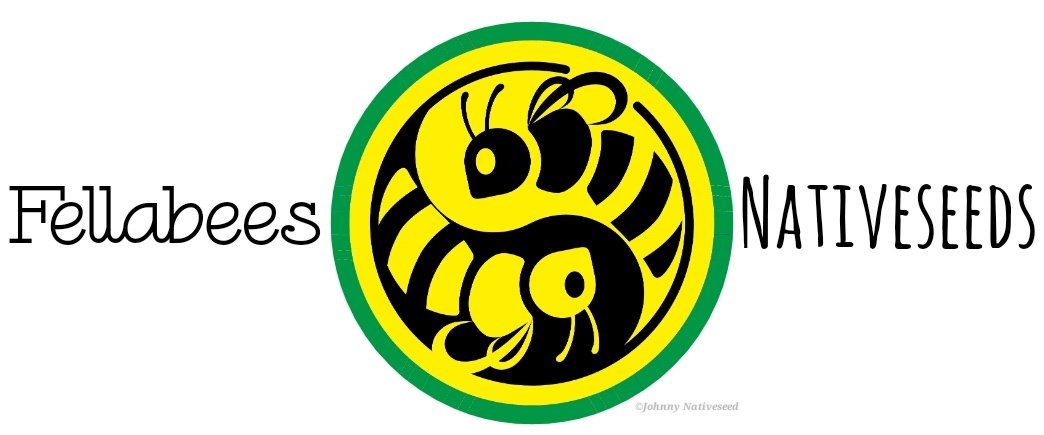 Image 1 of 7
Image 1 of 7

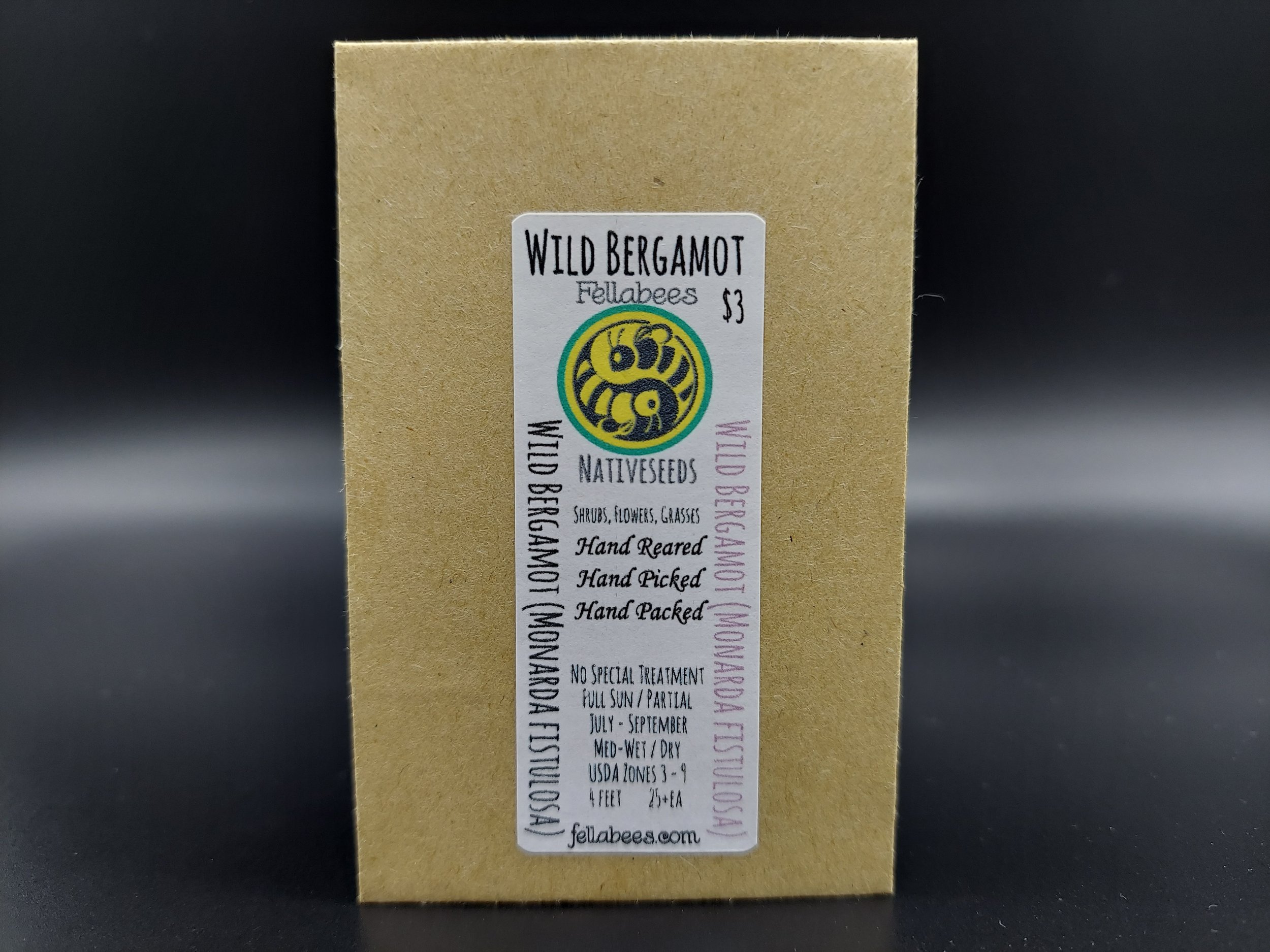 Image 2 of 7
Image 2 of 7

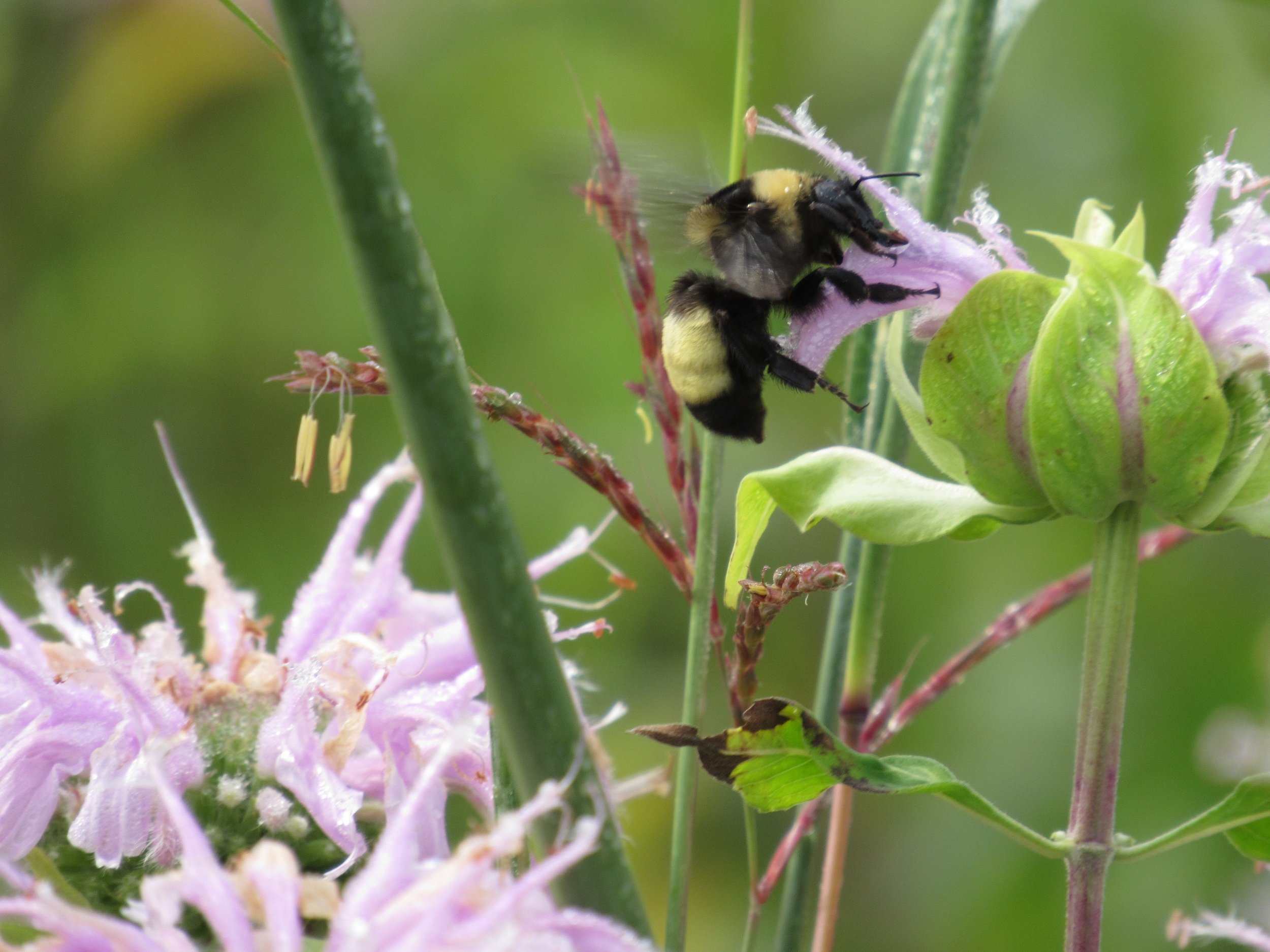 Image 3 of 7
Image 3 of 7

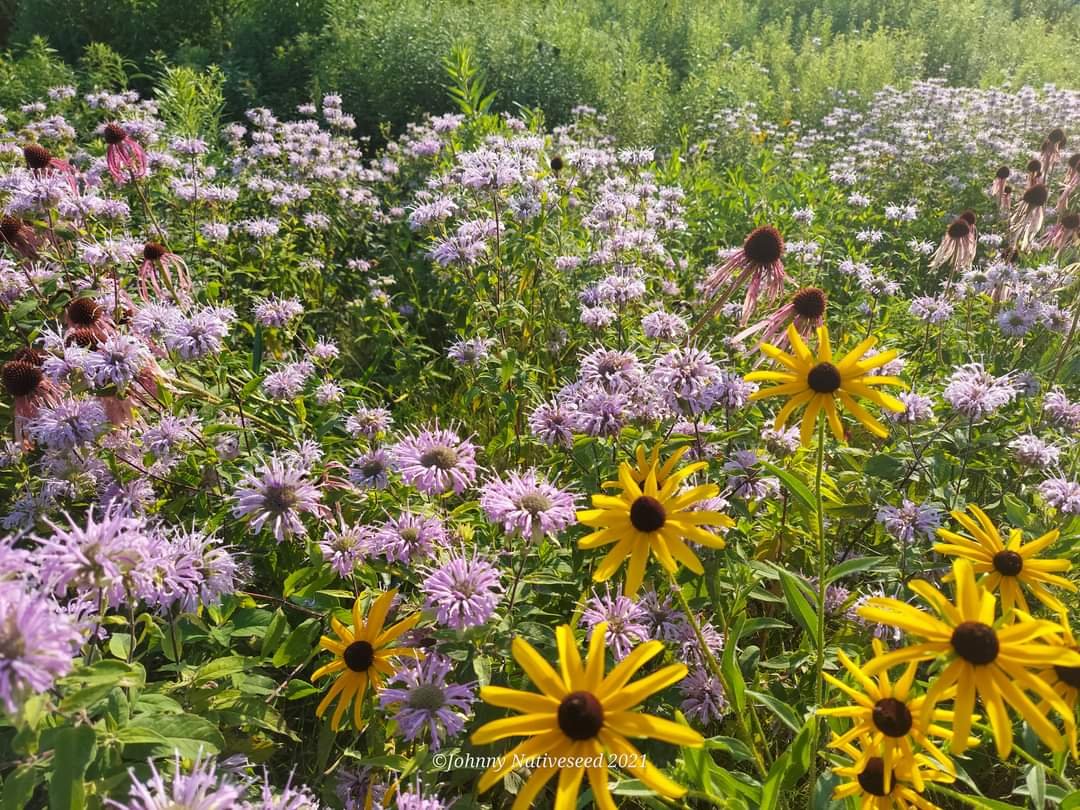 Image 4 of 7
Image 4 of 7

 Image 5 of 7
Image 5 of 7

 Image 6 of 7
Image 6 of 7

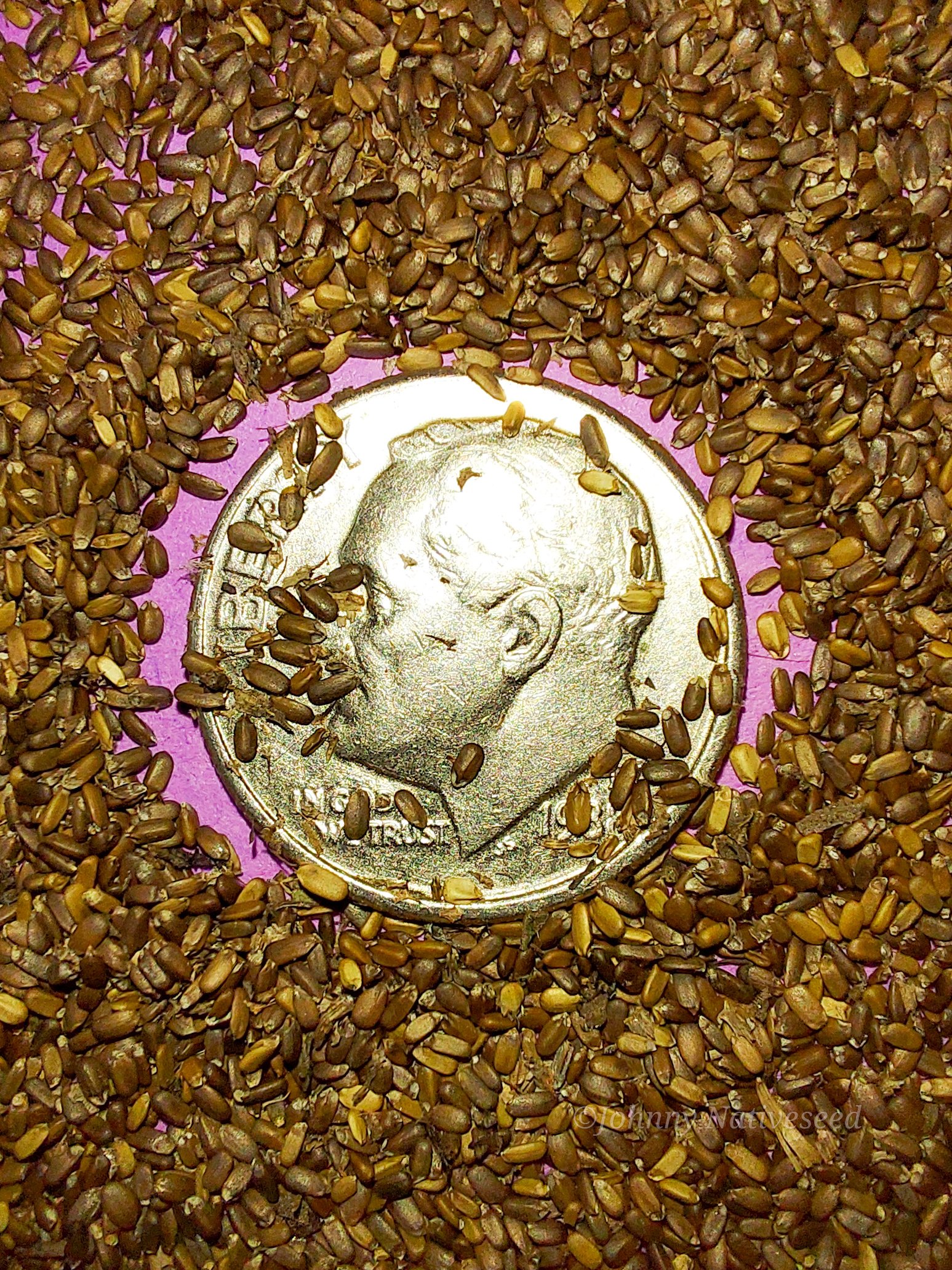 Image 7 of 7
Image 7 of 7








Wild Bergamot (Monarda fistulosa)
Wild Bergamot (Monarda fistulosa)
Our apologies here…this is one of our favorite natives, and it is too cool to not share all of its details! This description is LONG! Skip to the bottom to see details, or settle in for a long, but good read!
Monarda fistulosa: This species name, fistulosa is referring to its tube-like structure making up its crownlike blossom which begin to make their rowdy pollinator appearance in late June through to late September.
Wild Bergamot perfectly complements the wide spectrum of nearby blooming and fading of yellow composite flowers, like Rudbeckia, Silphium, and Helianthus, and the magenta and purple spikes of Liatris spires bursting and bustling with pollinators throughout!
Wild Bergamot is the original of several plants in the Monarda family also known by the common name of Bee Balm.
Wild Bergamot is dynamic prairie workhorse, attracting a wide number of specialist bees, bumble bees, predatory wasps, hummingbirds, and hawk moths!
Wild Bergamot is identified as a valuable Monarch Butterfly nectar plant in our years of observation.
Specialist bees and wasps
(Dufourea monardae) Is small black sweat bee, that is a solely dependent specialist of bee balm in the Midwest and Northeast, and would not exist without Monarda!
In the mid-Atlanic and Midwestern states, Sand Wasps (Bicyrtes) have been observed using Wild Bergamot extensively for nectar. These and many other wasps are voracious pollinating predators of the brown marmorated stinkbug (Halyomorpha halys), and of other plant sucking pests of agricultural orchards and vegetable crops.
Bicyrtes is a genus of large, often brightly coloured predatory Sand Wasp.
Many species in this genus work tirelessly, feeding on nectar to power their flights, while picking off and carefully packing their nests full with the paralyzed bodies of (Pentatomidae) while other species make use of (Reduviidae) and (Coreidae) instead.
This plant is well suited to long-tongued pollinators but is an absolute favorite as honey plant, it is popular with such a wide variety of pollinators, including all manner of bees, hummingbirds, and lepidoptera, both daytime flyers (Butterflies) and their nighttime counterparts (Moths). It plays as larval host to the Hermit Sphinx Moth, Orange Mint Moth, and the Raspberry pyrausta butterfly.
Locally, Wild Bergamot is the larval host to a mostly upper midwest moth, the Hermit Sphinx Moth (Lintneria eremitus).
The Hermit Sphinx caterpillars are cleverly nocturnal feeding exclusively at night and snoozing while hidden away during the day around the base of this extremely useful and beautiful plant!
This impressive species is found mostly in the ideally temperate regions of the eastern and central United States, stretching north into southern Canada and out over the Great Plains. It can be found in natural and native gardens and yards, but is fairly common wherever Wild Bergamot is found!
This moth can be easily confused with the Canadian Sphinx (Sphinx canadensis) but these two moths do not typically co-occur in their habitats.
To point out some interesting contrast, Wild Bergamot is listed as a historical native to be protected in Rhode Island, the smallest agricultural producer, but as a noxious weed in one of the nations biggest, Nebraska.
But be assured!!
This native plant is NO weed, noxious or otherwise by any stretch of the imagination!
Native Habitat:
Wild Bergamot grows in dry open woods, prairies, wet meadows, culverts and ditches, at the edges of woods it grows in the dappled shade of woodland emergent prairie and even in marshes where well-drained but moist sand, loam, clay soil conditions exist as well as in acidic or calcareous soils, throughout the USDA zones of 3 to 9.
Propagation Methods include:
Root Division, Seeds, and this plant lends itself well to being cloned.
Seed Collection Method:
Seeds ripen two months after plant completes its bloom cycle, and I use a tap method to collect properly cured seed. By gently grasping the stem and angling the head down into my collection container, I tap the the stem causing it to vibrate off the container, this is enough to loosen all the ripe seeds while leaving the ones that may still be green, and thus leaving them for birds and reseeding naturally.
Mature Plant Maintenance Method:
This plant easily colonizes available space though its rhizomes, so it is fairly easy to just lift it from the soil to divide every 3 years to propagate it while improving air circulation and plant vigor!
Wild Bergamot is diverse in its uses!
Wild Bergamot is entirely edible!
Its leaves can be dried and boiled for tea, it can be used for seasoning, chewed raw or dry, the flowers are delicious!
Wild Bergamot is also extremely valued as a historic medicinal!
Indigenous peoples used oil from the leaves to treat respiratory ailments, made tea from its leaves for treating colic, flatulence, colds, fevers, stomach aches, nosebleeds, insomnia, & heart trouble.
It became the go to medicine after colonists arrived bringing their measles, and it was then used to induce sweating, and they also pulticed leaves for relief from headaches. Boiling the dried plant to extract its essential oils, which is inhaled to relieve bronchial problems, oils of the plant are also used effectively to dry up pimples, its boiled leaves applied can be directly to pimples.
Tea from the flower clusters is used to relieve nausea, gas, and was notably favored by matriarchs of many Indigenous Tribes for aiding with menstrual pain and insomnia.
Wild bergamot was and still is considered a staple medicinal plant by many Indigenous Tribes who survived Spanish and European colonization, including the Menominee, the Ojibwe, Winnebago, and Blackfoot peoples among others. Indigenous families still make good use of its leaves as they are eaten boiled with meats and even a concoction of the plant can be made into hair pomade.
As mentioned above, this dynamic herb is considered to be an active diaphoretic (sweat inducing). Many families still use Wild Bergamot during the cold and flu season.
The tea may be sweetened with honey, and when possible honey bearing strong influences of Wild Bergamot nectar and pollen itself as the tea tends to be quite strong!
It was the Blackfoot peoples who made the discovery that a tea made from the leaves of Wild Bergamot could be used to treat mouth and throat infections caused by dental diseases and gingivitis. They recognized the antiseptic properties within was Wild Bergomot was highly beneficial.
Modern industry has widely adopted this powerful property, now named Thymol.
Thymeol is the primary active ingredient in modern commercial mouthwash formulas
Thymol, with its strengths as a powerful and natural antiseptic and fungicide, are known for being quite effective at treating the problematic Varroa destructor mite that attacks and feeds on bees in the families (Apis cerana) and (Apis mellifera) causing the disease varroosis.
Thymol from Wild Bergamot has also shown it can prevent honey fermentation, as well as prevent the growth of mold when applied to the empty comb of weaker bee colonies, or on wax comb in storage when out of season.
Thymol is also used as a quickly degrading, non-persistant pesticide, and can be used as a medical grade and food safe disinfectant.
Using mass spectrometry and arithmetical retention indices, Wild Bergamot was found to contain:
p-cymene (32.5%)
carvacrol (24.0%)
thymol (12.6%)
an aliphatic aldehyde (6.3%)
the methyl ether of carvacrol (5.5%)
α-pinene (3.5%)
β-pinene (2.9%)
sabinene hydrate (1.9%)
α-terpinene (1.7%)
citronellyl acetate (1.6%),
β-caryophyllene (1.1%)
M. fistulosa distillate (essential oil) has been proposed as an antimicrobial agent in laboratory and medical settings, and more specifically as an feeding agent in artificial media used for growth of tachinid fly larvae.
This plant while playing as host, food and provider of health to myriad pollinators and also completely useful to humans, is extremely resistant to rabbits and deer!
Taking advantage of this one is wise to plant thick borders with the members of native Monarda family and alongside Milkweeds they will easily protect the more sensitive and less deer and rabbit resistant native plants deeper in the prairie.
Plant Details
USDA Zones: 3-9
Germination Needs: No special treatment needed
Life Cycle: Perennial
Sun Exposure: Full to Partial
Soil Moisture: Medium-Wet, Medium, Medium-Dry, Dry
Plant Spacing: 2-3 feet
Height: 4 feet
Bloom Time: July, August, September
Bloom Color: Purple
Advantages
Pollinator Favorite: butterflies, moths, bees, wasps, beetles
Bird Favorite: seeds, insects, fruit, nectar, nesting, perchs.
Deer Resistant: Yes
Excellent in the home landscape!
Native to or present in: Every state in the lower 48, except California, and Florida.
.
.
Packet quantities:
We pride ourselves on ethical, hands on, ecological management, using no mechanical or chemical methods whatsoever.
All of our native seed is hand reared, hand picked, and hand packed from native prairies under our exclusive management, never breaking chain of custody from the field until it is sent to you. Each packet is hand prepared for shipment by us, directly.
Small seed species will contain greater than 20-25 seed
Large seed species will contain greater than 10-15 seed
It is our mission to spread the wealth of native plant and pollinator ecological sustainability, and educate back yard gardeners as well as corporate and government entities in how to germinate, grow, and benefit from native synergies.
Thank you for your support, it is because of you, that we can grow together to do, what we do.🐛🦋🐝🐞🌾🌱🌼🧡
Wild Bergamot (Monarda fistulosa)
Our apologies here…this is one of our favorite natives, and it is too cool to not share all of its details! This description is LONG! Skip to the bottom to see details, or settle in for a long, but good read!
Monarda fistulosa: This species name, fistulosa is referring to its tube-like structure making up its crownlike blossom which begin to make their rowdy pollinator appearance in late June through to late September.
Wild Bergamot perfectly complements the wide spectrum of nearby blooming and fading of yellow composite flowers, like Rudbeckia, Silphium, and Helianthus, and the magenta and purple spikes of Liatris spires bursting and bustling with pollinators throughout!
Wild Bergamot is the original of several plants in the Monarda family also known by the common name of Bee Balm.
Wild Bergamot is dynamic prairie workhorse, attracting a wide number of specialist bees, bumble bees, predatory wasps, hummingbirds, and hawk moths!
Wild Bergamot is identified as a valuable Monarch Butterfly nectar plant in our years of observation.
Specialist bees and wasps
(Dufourea monardae) Is small black sweat bee, that is a solely dependent specialist of bee balm in the Midwest and Northeast, and would not exist without Monarda!
In the mid-Atlanic and Midwestern states, Sand Wasps (Bicyrtes) have been observed using Wild Bergamot extensively for nectar. These and many other wasps are voracious pollinating predators of the brown marmorated stinkbug (Halyomorpha halys), and of other plant sucking pests of agricultural orchards and vegetable crops.
Bicyrtes is a genus of large, often brightly coloured predatory Sand Wasp.
Many species in this genus work tirelessly, feeding on nectar to power their flights, while picking off and carefully packing their nests full with the paralyzed bodies of (Pentatomidae) while other species make use of (Reduviidae) and (Coreidae) instead.
This plant is well suited to long-tongued pollinators but is an absolute favorite as honey plant, it is popular with such a wide variety of pollinators, including all manner of bees, hummingbirds, and lepidoptera, both daytime flyers (Butterflies) and their nighttime counterparts (Moths). It plays as larval host to the Hermit Sphinx Moth, Orange Mint Moth, and the Raspberry pyrausta butterfly.
Locally, Wild Bergamot is the larval host to a mostly upper midwest moth, the Hermit Sphinx Moth (Lintneria eremitus).
The Hermit Sphinx caterpillars are cleverly nocturnal feeding exclusively at night and snoozing while hidden away during the day around the base of this extremely useful and beautiful plant!
This impressive species is found mostly in the ideally temperate regions of the eastern and central United States, stretching north into southern Canada and out over the Great Plains. It can be found in natural and native gardens and yards, but is fairly common wherever Wild Bergamot is found!
This moth can be easily confused with the Canadian Sphinx (Sphinx canadensis) but these two moths do not typically co-occur in their habitats.
To point out some interesting contrast, Wild Bergamot is listed as a historical native to be protected in Rhode Island, the smallest agricultural producer, but as a noxious weed in one of the nations biggest, Nebraska.
But be assured!!
This native plant is NO weed, noxious or otherwise by any stretch of the imagination!
Native Habitat:
Wild Bergamot grows in dry open woods, prairies, wet meadows, culverts and ditches, at the edges of woods it grows in the dappled shade of woodland emergent prairie and even in marshes where well-drained but moist sand, loam, clay soil conditions exist as well as in acidic or calcareous soils, throughout the USDA zones of 3 to 9.
Propagation Methods include:
Root Division, Seeds, and this plant lends itself well to being cloned.
Seed Collection Method:
Seeds ripen two months after plant completes its bloom cycle, and I use a tap method to collect properly cured seed. By gently grasping the stem and angling the head down into my collection container, I tap the the stem causing it to vibrate off the container, this is enough to loosen all the ripe seeds while leaving the ones that may still be green, and thus leaving them for birds and reseeding naturally.
Mature Plant Maintenance Method:
This plant easily colonizes available space though its rhizomes, so it is fairly easy to just lift it from the soil to divide every 3 years to propagate it while improving air circulation and plant vigor!
Wild Bergamot is diverse in its uses!
Wild Bergamot is entirely edible!
Its leaves can be dried and boiled for tea, it can be used for seasoning, chewed raw or dry, the flowers are delicious!
Wild Bergamot is also extremely valued as a historic medicinal!
Indigenous peoples used oil from the leaves to treat respiratory ailments, made tea from its leaves for treating colic, flatulence, colds, fevers, stomach aches, nosebleeds, insomnia, & heart trouble.
It became the go to medicine after colonists arrived bringing their measles, and it was then used to induce sweating, and they also pulticed leaves for relief from headaches. Boiling the dried plant to extract its essential oils, which is inhaled to relieve bronchial problems, oils of the plant are also used effectively to dry up pimples, its boiled leaves applied can be directly to pimples.
Tea from the flower clusters is used to relieve nausea, gas, and was notably favored by matriarchs of many Indigenous Tribes for aiding with menstrual pain and insomnia.
Wild bergamot was and still is considered a staple medicinal plant by many Indigenous Tribes who survived Spanish and European colonization, including the Menominee, the Ojibwe, Winnebago, and Blackfoot peoples among others. Indigenous families still make good use of its leaves as they are eaten boiled with meats and even a concoction of the plant can be made into hair pomade.
As mentioned above, this dynamic herb is considered to be an active diaphoretic (sweat inducing). Many families still use Wild Bergamot during the cold and flu season.
The tea may be sweetened with honey, and when possible honey bearing strong influences of Wild Bergamot nectar and pollen itself as the tea tends to be quite strong!
It was the Blackfoot peoples who made the discovery that a tea made from the leaves of Wild Bergamot could be used to treat mouth and throat infections caused by dental diseases and gingivitis. They recognized the antiseptic properties within was Wild Bergomot was highly beneficial.
Modern industry has widely adopted this powerful property, now named Thymol.
Thymeol is the primary active ingredient in modern commercial mouthwash formulas
Thymol, with its strengths as a powerful and natural antiseptic and fungicide, are known for being quite effective at treating the problematic Varroa destructor mite that attacks and feeds on bees in the families (Apis cerana) and (Apis mellifera) causing the disease varroosis.
Thymol from Wild Bergamot has also shown it can prevent honey fermentation, as well as prevent the growth of mold when applied to the empty comb of weaker bee colonies, or on wax comb in storage when out of season.
Thymol is also used as a quickly degrading, non-persistant pesticide, and can be used as a medical grade and food safe disinfectant.
Using mass spectrometry and arithmetical retention indices, Wild Bergamot was found to contain:
p-cymene (32.5%)
carvacrol (24.0%)
thymol (12.6%)
an aliphatic aldehyde (6.3%)
the methyl ether of carvacrol (5.5%)
α-pinene (3.5%)
β-pinene (2.9%)
sabinene hydrate (1.9%)
α-terpinene (1.7%)
citronellyl acetate (1.6%),
β-caryophyllene (1.1%)
M. fistulosa distillate (essential oil) has been proposed as an antimicrobial agent in laboratory and medical settings, and more specifically as an feeding agent in artificial media used for growth of tachinid fly larvae.
This plant while playing as host, food and provider of health to myriad pollinators and also completely useful to humans, is extremely resistant to rabbits and deer!
Taking advantage of this one is wise to plant thick borders with the members of native Monarda family and alongside Milkweeds they will easily protect the more sensitive and less deer and rabbit resistant native plants deeper in the prairie.
Plant Details
USDA Zones: 3-9
Germination Needs: No special treatment needed
Life Cycle: Perennial
Sun Exposure: Full to Partial
Soil Moisture: Medium-Wet, Medium, Medium-Dry, Dry
Plant Spacing: 2-3 feet
Height: 4 feet
Bloom Time: July, August, September
Bloom Color: Purple
Advantages
Pollinator Favorite: butterflies, moths, bees, wasps, beetles
Bird Favorite: seeds, insects, fruit, nectar, nesting, perchs.
Deer Resistant: Yes
Excellent in the home landscape!
Native to or present in: Every state in the lower 48, except California, and Florida.
.
.
Packet quantities:
We pride ourselves on ethical, hands on, ecological management, using no mechanical or chemical methods whatsoever.
All of our native seed is hand reared, hand picked, and hand packed from native prairies under our exclusive management, never breaking chain of custody from the field until it is sent to you. Each packet is hand prepared for shipment by us, directly.
Small seed species will contain greater than 20-25 seed
Large seed species will contain greater than 10-15 seed
It is our mission to spread the wealth of native plant and pollinator ecological sustainability, and educate back yard gardeners as well as corporate and government entities in how to germinate, grow, and benefit from native synergies.
Thank you for your support, it is because of you, that we can grow together to do, what we do.🐛🦋🐝🐞🌾🌱🌼🧡
Wild Bergamot (Monarda fistulosa)
Our apologies here…this is one of our favorite natives, and it is too cool to not share all of its details! This description is LONG! Skip to the bottom to see details, or settle in for a long, but good read!
Monarda fistulosa: This species name, fistulosa is referring to its tube-like structure making up its crownlike blossom which begin to make their rowdy pollinator appearance in late June through to late September.
Wild Bergamot perfectly complements the wide spectrum of nearby blooming and fading of yellow composite flowers, like Rudbeckia, Silphium, and Helianthus, and the magenta and purple spikes of Liatris spires bursting and bustling with pollinators throughout!
Wild Bergamot is the original of several plants in the Monarda family also known by the common name of Bee Balm.
Wild Bergamot is dynamic prairie workhorse, attracting a wide number of specialist bees, bumble bees, predatory wasps, hummingbirds, and hawk moths!
Wild Bergamot is identified as a valuable Monarch Butterfly nectar plant in our years of observation.
Specialist bees and wasps
(Dufourea monardae) Is small black sweat bee, that is a solely dependent specialist of bee balm in the Midwest and Northeast, and would not exist without Monarda!
In the mid-Atlanic and Midwestern states, Sand Wasps (Bicyrtes) have been observed using Wild Bergamot extensively for nectar. These and many other wasps are voracious pollinating predators of the brown marmorated stinkbug (Halyomorpha halys), and of other plant sucking pests of agricultural orchards and vegetable crops.
Bicyrtes is a genus of large, often brightly coloured predatory Sand Wasp.
Many species in this genus work tirelessly, feeding on nectar to power their flights, while picking off and carefully packing their nests full with the paralyzed bodies of (Pentatomidae) while other species make use of (Reduviidae) and (Coreidae) instead.
This plant is well suited to long-tongued pollinators but is an absolute favorite as honey plant, it is popular with such a wide variety of pollinators, including all manner of bees, hummingbirds, and lepidoptera, both daytime flyers (Butterflies) and their nighttime counterparts (Moths). It plays as larval host to the Hermit Sphinx Moth, Orange Mint Moth, and the Raspberry pyrausta butterfly.
Locally, Wild Bergamot is the larval host to a mostly upper midwest moth, the Hermit Sphinx Moth (Lintneria eremitus).
The Hermit Sphinx caterpillars are cleverly nocturnal feeding exclusively at night and snoozing while hidden away during the day around the base of this extremely useful and beautiful plant!
This impressive species is found mostly in the ideally temperate regions of the eastern and central United States, stretching north into southern Canada and out over the Great Plains. It can be found in natural and native gardens and yards, but is fairly common wherever Wild Bergamot is found!
This moth can be easily confused with the Canadian Sphinx (Sphinx canadensis) but these two moths do not typically co-occur in their habitats.
To point out some interesting contrast, Wild Bergamot is listed as a historical native to be protected in Rhode Island, the smallest agricultural producer, but as a noxious weed in one of the nations biggest, Nebraska.
But be assured!!
This native plant is NO weed, noxious or otherwise by any stretch of the imagination!
Native Habitat:
Wild Bergamot grows in dry open woods, prairies, wet meadows, culverts and ditches, at the edges of woods it grows in the dappled shade of woodland emergent prairie and even in marshes where well-drained but moist sand, loam, clay soil conditions exist as well as in acidic or calcareous soils, throughout the USDA zones of 3 to 9.
Propagation Methods include:
Root Division, Seeds, and this plant lends itself well to being cloned.
Seed Collection Method:
Seeds ripen two months after plant completes its bloom cycle, and I use a tap method to collect properly cured seed. By gently grasping the stem and angling the head down into my collection container, I tap the the stem causing it to vibrate off the container, this is enough to loosen all the ripe seeds while leaving the ones that may still be green, and thus leaving them for birds and reseeding naturally.
Mature Plant Maintenance Method:
This plant easily colonizes available space though its rhizomes, so it is fairly easy to just lift it from the soil to divide every 3 years to propagate it while improving air circulation and plant vigor!
Wild Bergamot is diverse in its uses!
Wild Bergamot is entirely edible!
Its leaves can be dried and boiled for tea, it can be used for seasoning, chewed raw or dry, the flowers are delicious!
Wild Bergamot is also extremely valued as a historic medicinal!
Indigenous peoples used oil from the leaves to treat respiratory ailments, made tea from its leaves for treating colic, flatulence, colds, fevers, stomach aches, nosebleeds, insomnia, & heart trouble.
It became the go to medicine after colonists arrived bringing their measles, and it was then used to induce sweating, and they also pulticed leaves for relief from headaches. Boiling the dried plant to extract its essential oils, which is inhaled to relieve bronchial problems, oils of the plant are also used effectively to dry up pimples, its boiled leaves applied can be directly to pimples.
Tea from the flower clusters is used to relieve nausea, gas, and was notably favored by matriarchs of many Indigenous Tribes for aiding with menstrual pain and insomnia.
Wild bergamot was and still is considered a staple medicinal plant by many Indigenous Tribes who survived Spanish and European colonization, including the Menominee, the Ojibwe, Winnebago, and Blackfoot peoples among others. Indigenous families still make good use of its leaves as they are eaten boiled with meats and even a concoction of the plant can be made into hair pomade.
As mentioned above, this dynamic herb is considered to be an active diaphoretic (sweat inducing). Many families still use Wild Bergamot during the cold and flu season.
The tea may be sweetened with honey, and when possible honey bearing strong influences of Wild Bergamot nectar and pollen itself as the tea tends to be quite strong!
It was the Blackfoot peoples who made the discovery that a tea made from the leaves of Wild Bergamot could be used to treat mouth and throat infections caused by dental diseases and gingivitis. They recognized the antiseptic properties within was Wild Bergomot was highly beneficial.
Modern industry has widely adopted this powerful property, now named Thymol.
Thymeol is the primary active ingredient in modern commercial mouthwash formulas
Thymol, with its strengths as a powerful and natural antiseptic and fungicide, are known for being quite effective at treating the problematic Varroa destructor mite that attacks and feeds on bees in the families (Apis cerana) and (Apis mellifera) causing the disease varroosis.
Thymol from Wild Bergamot has also shown it can prevent honey fermentation, as well as prevent the growth of mold when applied to the empty comb of weaker bee colonies, or on wax comb in storage when out of season.
Thymol is also used as a quickly degrading, non-persistant pesticide, and can be used as a medical grade and food safe disinfectant.
Using mass spectrometry and arithmetical retention indices, Wild Bergamot was found to contain:
p-cymene (32.5%)
carvacrol (24.0%)
thymol (12.6%)
an aliphatic aldehyde (6.3%)
the methyl ether of carvacrol (5.5%)
α-pinene (3.5%)
β-pinene (2.9%)
sabinene hydrate (1.9%)
α-terpinene (1.7%)
citronellyl acetate (1.6%),
β-caryophyllene (1.1%)
M. fistulosa distillate (essential oil) has been proposed as an antimicrobial agent in laboratory and medical settings, and more specifically as an feeding agent in artificial media used for growth of tachinid fly larvae.
This plant while playing as host, food and provider of health to myriad pollinators and also completely useful to humans, is extremely resistant to rabbits and deer!
Taking advantage of this one is wise to plant thick borders with the members of native Monarda family and alongside Milkweeds they will easily protect the more sensitive and less deer and rabbit resistant native plants deeper in the prairie.
Plant Details
USDA Zones: 3-9
Germination Needs: No special treatment needed
Life Cycle: Perennial
Sun Exposure: Full to Partial
Soil Moisture: Medium-Wet, Medium, Medium-Dry, Dry
Plant Spacing: 2-3 feet
Height: 4 feet
Bloom Time: July, August, September
Bloom Color: Purple
Advantages
Pollinator Favorite: butterflies, moths, bees, wasps, beetles
Bird Favorite: seeds, insects, fruit, nectar, nesting, perchs.
Deer Resistant: Yes
Excellent in the home landscape!
Native to or present in: Every state in the lower 48, except California, and Florida.
.
.
Packet quantities:
We pride ourselves on ethical, hands on, ecological management, using no mechanical or chemical methods whatsoever.
All of our native seed is hand reared, hand picked, and hand packed from native prairies under our exclusive management, never breaking chain of custody from the field until it is sent to you. Each packet is hand prepared for shipment by us, directly.
Small seed species will contain greater than 20-25 seed
Large seed species will contain greater than 10-15 seed
It is our mission to spread the wealth of native plant and pollinator ecological sustainability, and educate back yard gardeners as well as corporate and government entities in how to germinate, grow, and benefit from native synergies.
Thank you for your support, it is because of you, that we can grow together to do, what we do.🐛🦋🐝🐞🌾🌱🌼🧡
